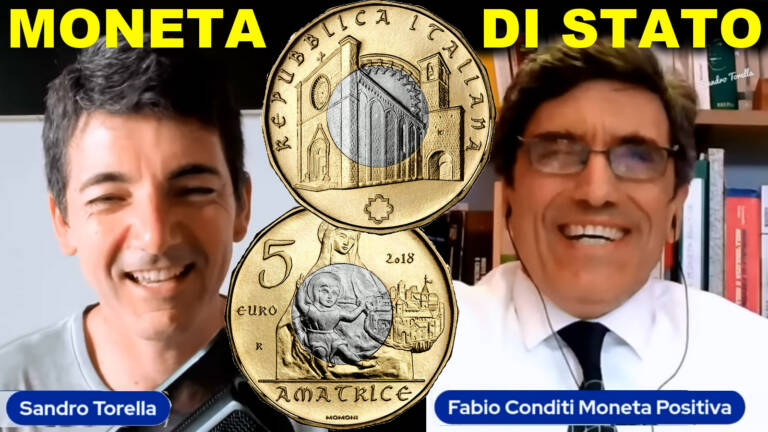State currency

In this interview with Sandro Torella we address the issue of state money, because everyone now believes that only the banking system can create money.
According to article 128 paragraph 2 of the Treaty on the Functioning of the European Union, “ Member States may mint euro coins with the approval of the European Central Bank as regards the volume of the minting. The Council, on a proposal from the Commission and after consulting the European Parliament and the European Central Bank, may adopt measures to harmonize the denominations and technical specifications of all coins intended for circulation, to the extent necessary to facilitate their circulation in the Union “.
The coins intended for circulation in the Union are the standard ones we know from 10 cents to 2 euro, but also the commemorative 2 euro coins. Obviously if you look at them in detail, the origin from each state is clearly recognizable in one of the two faces, because it contains symbols of the country that mints them, as an exercise of its monetary sovereignty. Italy has a superimposed “R” and “I” which are the initials of the Italian Republic.
But there is another category of coins, defined as "collector's coins", which can be issued by States with values different from those established by the ECB, in Italy from 5, 10, 20 and 50 euros, but in other States also strange values such as 2.5-3-7.5 euros. These coins are subject to the approval of the minting volume by the ECB, but the states mint very different quantities and the ECB has always approved them. In particular, Germany and Austria stand out for minting quite large quantities, the Germans 50% of the others, while the Austrians 200% of the others.
It is curious to point out that according to article 5 of EU Regulation no. 651/2012, “ 1. Collector coins are legal tender only in the
issuing Member State" and in the same article " 5. Member States shall take all necessary measures to discourage the use of collector coins as a payment instrument ". Collector coins are therefore legal tender, ie with mandatory acceptance, and can circulate, but Member States are advised to "discourage" their use as a payment instrument. In practice it is like cigarettes, which are allowed to smoke but the State, with the writing on the packets, "discourages" their use.
However in 2016 I proposed in a Conference in the Chamber of Deputies to mint 5 and 10 euro coins with the monuments destroyed by the earthquake of Marche and Umbria, in particular the cathedrals of Amatrice and Norcia, and finally in 2018 the State Mint minted a coin from 5 euros on Amatrice very similar to the one I designed.
The peculiarity of these coins is that they have the full inscription "Italian Republic" demonstrating that monetary sovereignty is still legally of the Italian State, as also declared by the Bank of Italy on its website on the page dedicated to seigniorage, where in the center and in bold he writes: “ Today, therefore, seigniorage is first perceived by the central banks, which, however, then pass it on to the states, the ultimate holders of monetary sovereignty . The main difference lies in the ways in which seigniorage is formed. When money is produced by the State , it is the latter which, by spending it for example to purchase goods and services, puts it into circulation in the economy and immediately realizes the equivalent value, net of production costs. When, on the other hand, the central bank issues the banknotes (or, more generally, the monetary base, which also includes the reserves set up by the banks on accounts with the central bank), these are not spent on goods and services but supplied to the commercial banks , in the form of a loan, for the needs of the economic system, or used for the purchase of financial assets, such as government bonds or foreign currency assets; the value of the banknotes, entered in the balance sheet liabilities of the central bank, therefore corresponds to the entry of interest-bearing assets in the balance sheet assets, which yield interest. ”
In conclusion, not only can the State mint metal coins, but it fully perceives their seigniorage, given by the difference between the nominal value and the cost of minting, which obviously increases if the number of pieces approaches that of Germany (3-4 million of pieces for each coin) and not if we remain on Italy's editions of 15-20,000 pieces only.
Metallic collectible coins could therefore be minted in quantities exceeding one million pieces for each coin, representing the monuments of our great building and artistic heritage, so that the related seigniorage could be used to recover and enhance it.
Fabio Conditioni
President of Positive Money

Thanks to our Telegram channel you can stay updated on the publication of new articles from Economic Scenarios.
The article State currency comes from Scenari Economici .
This is a machine translation of a post published on Scenari Economici at the URL https://scenarieconomici.it/moneta-di-stato/ on Wed, 14 Jun 2023 14:00:58 +0000.
